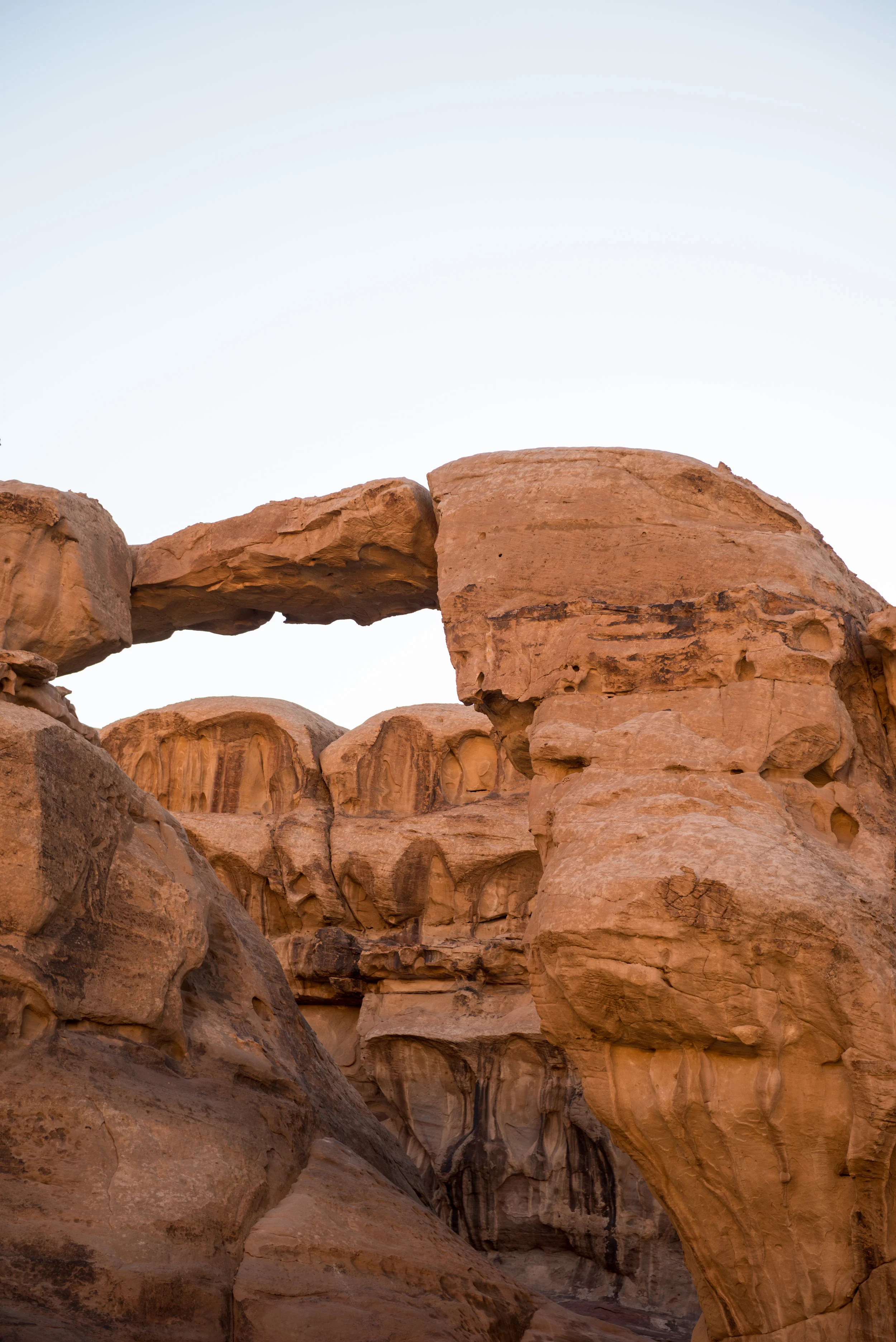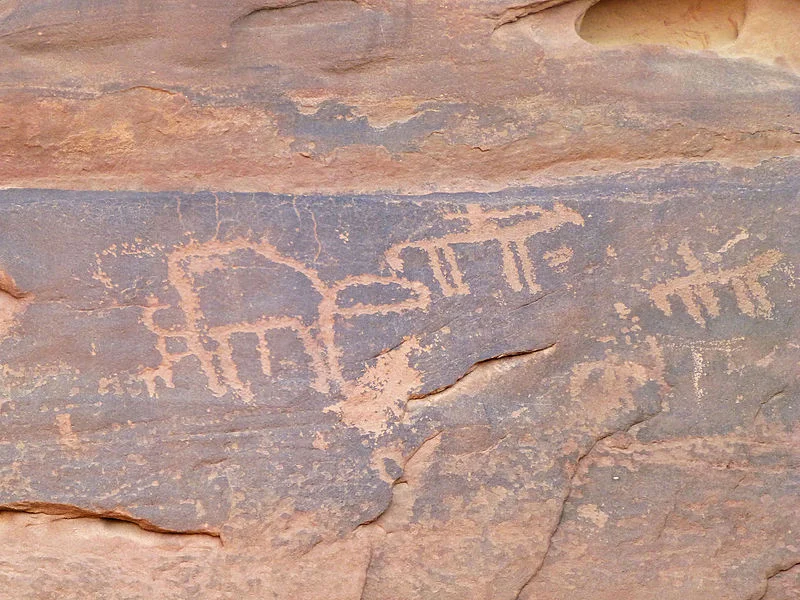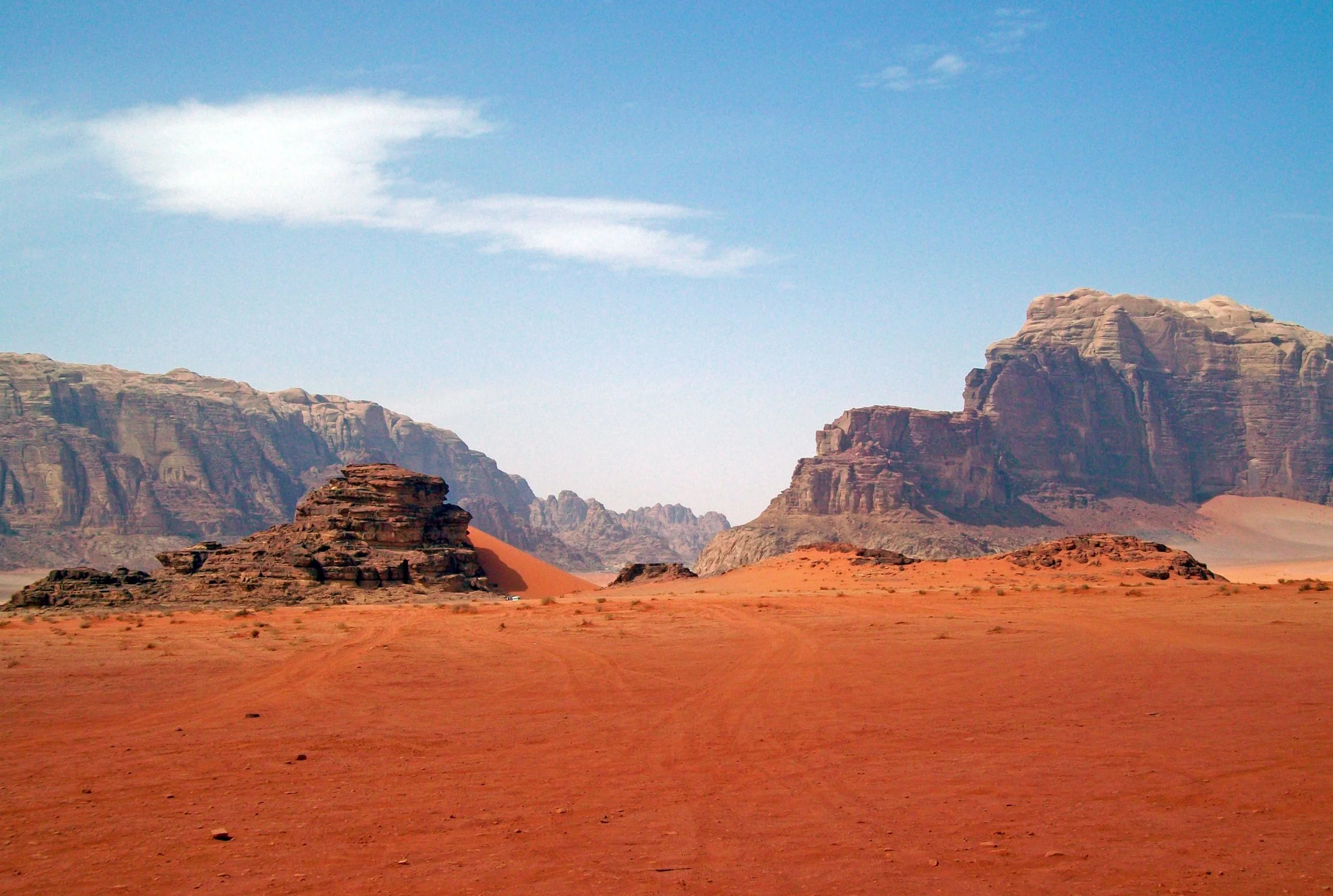When reading about Wadi Rum online, you are bound to find countless travel blogs and social media posts detailing visitors’ experiences in our beautiful desert. While these are often great reads, they are certain to become repetitive the more you read. In this post, we’ve put together a collection of articles from across the internet which talk about Wadi Rum from different points of view.
Arkadiusz Podniesiński finds an abandoned palace in southern Wadi Rum
Photograph by ARKADIUSZ PODNIESIŃSKI from his article, “I Found an Abandoned ‘Palace’ in the Desert, It’s Actually a Gameshow Set” on PetaPixel.
The southern half of the Wadi Rum Protected Area is much more visited than the northern half. The village, camps, and most of the famous sites are located closer to the Protected Area’s northern border. As you travel south, you will find yourself feeling more and more isolated. The desert becomes silent, and sometimes you come across some strange things. This was especially true for Arkadiusz Podniesiński, a Polish photographer and filmmaker, who visited Wadi Rum this summer.
While exploring the southern, lesser-known part of the Jordanian desert Wadi Rum, I notice a remarkable, palace-like structure sitting on a high, rocky cliff. The view reminded me of a scene from the classic Oscar-winning film Lawrence of Arabia. It just lacked camel caravans and people.
Who lived in such a place and why did they decide to abandon it? Perhaps the abandoned structure was the set for a film I was unfamiliar with. The harsh background recalls those against which The Martian, Rogue 1, A Star Wars Story, Red Planet or Prometheus were filmed. My curiosity piqued, I headed closer.
The huge wooden gates won’t budge a millimeter, as if they intentionally do not wish to reveal the secrets lurking behind them. Luckily, the back of the complex isn’t fortified, making it easier to get inside.
What Podniesiński came across wasn’t an ancient fortress built by the Nabataens or the Bedouin. It was in fact a game show set which is now being overrun by sand as it slowly sinks below the surface. Inside he found trap doors, gates, crushers, and other strange devices. The palace certainly didn’t belong to any ancient civilization, but initially it left him with more questions than answers.
After a bit of research, he determined that the complex belonged to a game show set from the late 1990s. The Desert Forges (Les Forges du Désert in French) was a French game show broadcast on France 2 in 1999 and 2000. Six episodes were produced however only three were broadcast due to poor viewership. That wasn’t the end of the palace however. British and Quebecois versions of the show were produced and shown in 2001 and 2002. You can watch the intro to the British version below. .
You can read the full article and view some great photos of the abandoned TV set on PetaPixel by clicking here.
Locals are Using an App to Document Ancient Inscriptions
Photograph by Ji-Elle, shared under a CC BY-SA 4.0 license.
The Wadi Rum Protected Area is absolutely full of rock art; petroglyphs and ancient inscriptions. UNESCO estimates that there are over 25 000 petroglyphs and 20 000 inscriptions in the Protected Area. Atlas Obscura, a website that writes articles about lesser known or off the beaten path things to see and do around the world, published an article about how the locals in Wadi Rum are using a new technique to preserve their heritage through documenting this rock art.
An app has been developed which allows the local people based in Wadi Rum and the nearby areas to catalog the rock art that they come across using their smart phones. The article explains:
Here’s how it works. You find a rock art panel, and then make a sketch or take a photograph of it while noting its GPS coordinates. You then have a list of 36 different rock-decay forms you have to identify, scoring them between a zero (no damage) and a three (this type of damage dominates the rock panel). Extra detail on the quality of the panel and what it shows is permitted. In order to erase bias, you can get multiple people to judge the same rock art panel and average out their scores.
You can read the full article on Atlas Obscura by clicking here. If you are interested in seeing more rock art during your time in Wadi Rum, please let us know. We are happy to tailor our tours to meet our guests’ wishes.
National Geographic lists Wadi Rum as one of the Earth’s Top 10 most Alien Landscapes
Photograph by Daniel Case, shared under a CC BY-SA 3.0 license.
The fact that Wadi Rum looks like Mars shouldn’t be surprising to anyone. It’s often one of the reason why people are drawn to Wadi Rum in the first place. Its landscapes are a photographer’s paradise and several films (such as The Martian) have been shot in Wadi Rum due to its resemblance to the red planet. It therefore comes as no surprise that Wadi Rum was listed in National Geographic’s list of Earth’s 10 Most Alien Landscapes.
Other locations making the list were the Danakil Depression in Ethiopia, Salar de Uyuni in the Bolivian Andes, and the Borup Fiord Pass in Northern Canada. You can see all of National Geographic’s photo galleries by clicking here.
An experimental festival descends on Wadi Rum
Photograph taken by Mohammed Zakaria.
This past June, a collection of artists from all around the Arab World gathered in Wadi Rum for Sarāb 2019. Jordan was chosen as the location as it is the easiest country for Middle Eastern passport holders to visit without any visa headaches. Over 150 people were able to make the trip to Wadi Rum for what organizers hope to turn into an annual event.
The author, Tom Faber, explains:
Sarāb means "mirage" in Arabic, a gesture to the transience of a music festival in the wilderness. The site overlooked a rust-coloured plain, with a dance floor of sand strewn with Bedouin-style carpets. The desert infused every act with its ancient aura, but some of the best performers actively used the land in their live sets. First was Nicolas Jaar, who sat on the ground and live-looped the sound of dancer Stéphanie Janaina raking stones across the sand. He used that scrape and metallic thud as a percussive backdrop for half the set, adding eerie washes of melody that rose like a ghostly choir. Janaina flexed as if fighting paralysis, and at one point Jaar winced—perhaps overcome by the harsh tones he was conjuring, or maybe because sand was flying in his face.
You can read Tom’s full article on Resident Advisor by clicking here.
Will Smith Discusses his Wadi Rum Experience
This spring, Disney released an live action adaptation of their 1992 animated film which is considered a classic by Disney fans around the world. The story is based on a tale from One Thousand and One Nights, a famous collection of Arabic folk tales from the Islamic Golden Age. The film stars Mena Massoud as Aladin, Naomi Scott as Princess Jasmine, and Will Smith as the Genie. A significant amount of the film was shot in our very own Wadi Rum Desert.
The Jordan Times interviewed Smith before the film premiered in Amman to ask him about his time in the desert. Here are a few quotes:
“For me it was absolutely spectacular,” Smith, who plays the Genie in the 2019 picture, told reporters during a press conference in Amman on Monday, attended by the film’s cast and director.
The film, parts of which were shot in Jordan’s Wadi Rum last year, will be screened in the Kingdom on May 23.
“What happens with actors when [they] travel to locations, [is that] everything changes inside of you. When we landed in Jordan, all of a sudden you begin to embody the feelings of the characters,” the Hollywood star told the press.
You can read the full article, including quotes others involved with the production of the film, by clicking here.
Wadi Rum Nature Tours offers tours and accommodation in the Wadi Rum Desert, a UNESCO World Heritage Site in the south of Jordan. If you are planning a trip to Jordan, click here to read about our tours and our accommodation in beautiful Wadi Rum.







